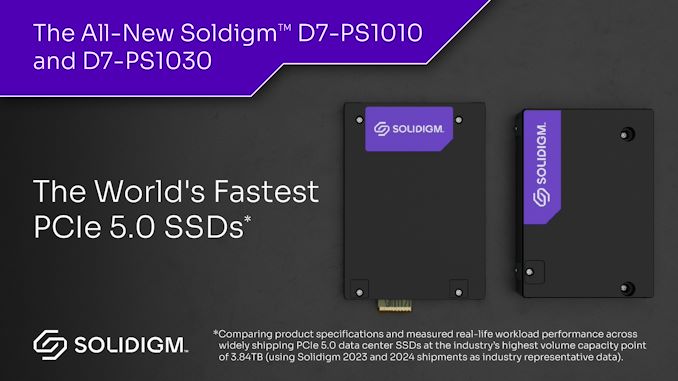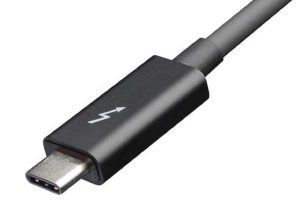
Solidigm’s datacenter SSD lineup includes models targeting different performance, endurance, and cost tradeoffs. Last year, the company had introduced the D5-P5336 QLC drive as a low-cost high-capacity drive for read-heavy workloads, while also preparing the SLC-based D7-P5810 for extremely write-intensive workloads requiring high endurance. The D7-P5520 / D7-P5620 Gen 4 drives with Solidigm’s own 144L 3D TLC have been the high-performance offerings for generic workloads over the last couple of years.
Solidigm is announcing the availability of the successor to the D7-P5x20 today – the new D7-PS1010 and D7-PS1030. Both of these NVMe drives use SK hynix’s 176L 3D TLC NAND and come with a PCIe 5.0 interface. The third digit in the model number matches the DWPD rating, with the D7-PS1010 targeting mixed workloads with a 1 DWPD rating, and the D7-PS1030 targeting write-intensive use-cases with a 3 DWPD rating.

Compared to the previous generation D7-P5x20, the D7-PS10x0 series brings about the following upgrades:
- Move from PCIe 4.0 x4 to PCIe 5.0 x4
- Move from 144L floating gate 3D TLC (Solidigm) to 176L charge trap 3D TLC (SK hynix)
- 25% longer mean-time between failures (MTBF) at 2.5M hours
- 10x higher uncorrectable bit-error rate (UBER) at 1E-18
- 1.8x to 2.8x improvement in high queue-depth random access IOPS
- 2.0x to 2.2x improvement in high queue-depth sequential access throughput
The specifications of the two new SSD families are summarized in the table below.
| Solidigm D7-PS1000 Series Enterprise SSDs | ||
| D7-PS1030 | D7-P1010 | |
| Form Factor | U.2 2.5″ 15mm E3.S 7.5mm | |
| Interface | PCIe 5.0 NVMe 2.0 | |
| Capacities | 1.6TB 3.2TB 6.4TB 12.8TB | 1.92TB 3.68TB 7.68TB 15.36TB |
| NAND | SK hynix 176L 3D TLC (Charge Trap Architecture) | |
| Sequential Read (128 KB @ QD 128) | 14500 MB/s | |
| Sequential Write (128 KB @ QD 128) | 4100 MB/s (1.6 TB / 1.92 TB) 8200 MB/s (3.2 TB / 3.84 TB) 9300 MB/s (6.4 TB / 7.68 TB / 12.8 TB / 15.36 TB) | |
| Random Read (4 KB @ QD 512) | 2.35 M (1.6 TB / 1.92 TB) 3.1 M (3.2 TB / 3.84 TB) 2.8 M (6.4 TB / 7.68 TB) 2.75 M (12.8 TB / 15.36 TB) | |
| Random Write (4 kB) | 0.35 M (1.6 TB) 0.716 M (3.2 TB) 0.8 M (6.4 TB / 12.8 TB) | 0.15 M (1.92 TB) 0.315 M (3.84 TB) 0.4 M (7.68 TB) 0.38 M (15.36 TB) |
| Power | Sustained Write | 13 W (1.6 TB / 1.92 TB) 18 W (3.2 TB / 3.84 TB) 23 W (6.4 TB / 7.68 TB / 12.8 TB / 15.36 TB) |
| Sustained Read | 17 W (1.6 TB / 1.92 TB) 19 W (3.2 TB / 3.84 TB) 22 W (6.4 TB / 7.68 TB) 23 W (12.8 TB / 15.36 TB) | |
| Peak | 18 W (1.6 TB / 1.92 TB) 22 W (3.2 TB / 3.84 TB) 29 W (6.4 TB / 7.68 TB) 30 W (12.8 TB / 15.36 TB) | |
| Idle | 5 W | |
| Write Endurance | 3 DWPD | 1 DWPD |
| Warranty | 5 years |
Based on Solidigm’s own internal testing, the D7-PS1010 compares very favorably against the Gen 5 datacenter SSDs already in the market from Samsung and Kioxia. However, the recently introduced Micron 9550 series may present a better challenge to Solidigm’s claims.
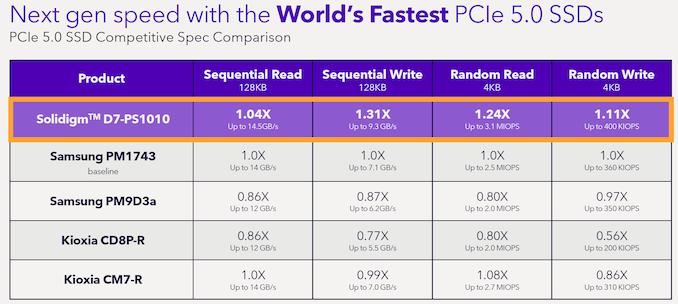
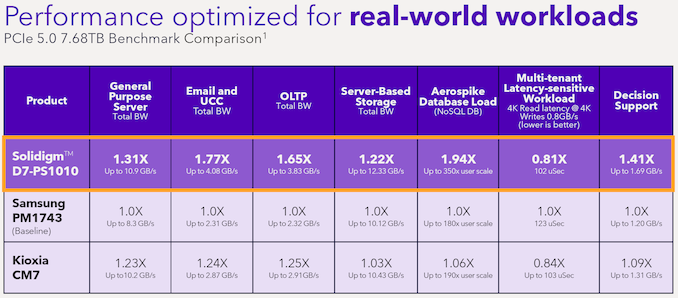
Gen 5 SSDs are well-suited for the storage-intensive tasks in AI workloads. Every new product needs to tie itself to the AI buzzword currently, but we should excuse SSD manufacturers for doing the same – after all training and inference needs to move large amounts of data back and forth between the processing engine and underlying memory. Solidigm expects the D7-PS10x0 to be a good fit as direct-attached storage internal to GPU servers or as all-flash tier supporting a HDD-only object tier in the cloud. For on-premises GPU servers, the flash / HDD tiered storage can be replaced by an all-QLC object tier.
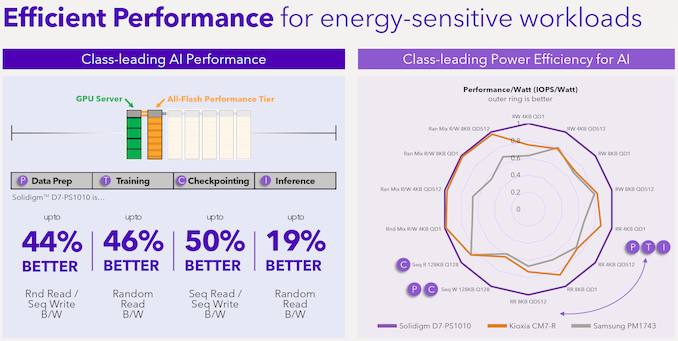
Solidigm claims better energy efficiency compared to the competitors’ Gen 5 drives from last year for various AI workload traces. While the data ingest and archival processes require system designers to maximize the storage capacity per watt (the QLC-based Solidigm D5-P5336 is attractive here), the core processing steps require the optimization of performance per watt. The D7-PS10x0 have a natural fit in this segment.
Solidigm / Intel has been serving the datacenter SSD market since its inception. The company is well aware of the quality and reliability requirements in this space. The D7-PS1010 and D7-PS1030 include the usual enhanced PLI (power loss imminent) validation checks for data saved in the process of power loss / restoration. The critical SRAMs in the SSD controller also have ECC protection. UBER testing goes well beyond the suggested JEDEC specifications. The company also claims that its silent data corruption testing and modeling are better than its competitors.
The new D7-PS1010 and D7-PS1030 bring class-leading Gen 5 performance to the datacenter SSD market. They are available for purchase now in both U.2 and E3.S form factors, with capacities ranging from 1.6 TB – 12.8 TB (D7-PS1030) and 1.92 TB – 15.36 TB (D7-PS1010).

